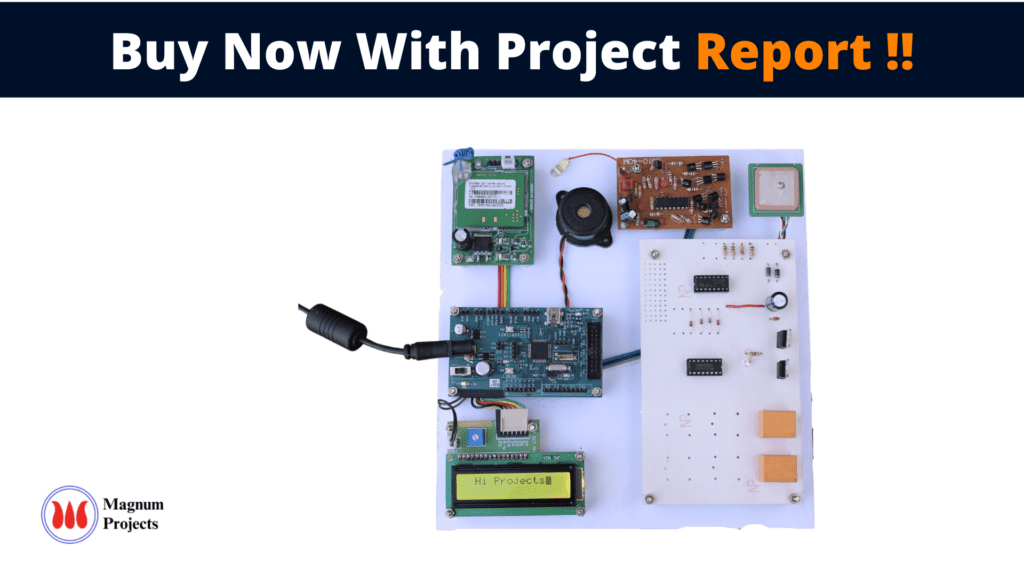Table of Contents
Introduction:

With the increasing population in places like metropolitan cities, the problem of transportation services has increased. The nonavailability of information about buses arrival schedule, people have to wait for a longer time at bus stops especially during working hours and office hours. Sometimes this leads to an overload of buses. These are the regions where buses are more overloaded. The solution to the problem lies in increasing the number of buses. In this system, a transportation management system is developed for enhancing public transportation services based on the integration of GPS and GSM. GPS is used as a positioning device while GSM is used as a communication link between different modules. These modules include BUS Station Module and Bus Module. Bus Station Module contains a GSM engine interfaced with Microcontroller and transmits the bus information to Bus Module. At the same time, it turns on the GPS receiver installed in the bus. The bus then starts transmitting its location to the Bus Station & when the bus reaches that particular Bus station that information will Display on the Bus Station and the buzzer will be turned ‘ON’.

Block diagram explanation :
Power supply unit:
This section needs two voltages viz., +12 V & +5 V, as working voltages. Hence specially designed power supply is constructed to get regulated power supplies.
GPS module:
This is a GPS Receiver (5V Serial) with high gain having 4 Pin 2.54mm pitch strip. The third-generation POT (Patch Antenna on Top) is used by the receiver for the GPS module. It can be interfaced with normal 5V ARM7 with the help of the in-built 3V-5V converter. The interfacing is made easier with the help of a low pin count (4-pin) strip. The 4 Pins are 5V, TX, RX, and GND. This standalone 5V GPS Module does not require external components. It consists of an internal RTC Back up battery and can be directly connected to the USART of the ARM7.
The current date, time, longitude, latitude, altitude, speed, and travel direction / heading among other data, are provided by the module and can be used in many applications including navigation, fleet management, tracking systems, mapping, and robotics. The module can support up to 51 channels. The GPS solution enables small form factor devices which deliver major advancements in GPS performance, accuracy, integration, computing power, and flexibility. They are used to simplify the embedded system integration process.
GSM:
GSM Shield (SIM 900a): The SIM900 which is a complete Quad-band GSM/GPRS solution comes in a SMT module that can be embedded in customer applications. Featuring an industry-standard interface, the SIM900 delivers GSM/GPRS 850/900/1800/1900MHz performance for Data, voice, SMS, and Fax in a small form factor and with low power consumption. SIM900 can fit almost all the space requirements in the M2M application with dimensions of 24mm x 24mm x 3 mm. SIM900 is designed with a very powerful single-chip processor integrating AMR926EJ-S core. Quad-band GSM/GPRS module with a size of 24mmx24mmx3mm, SMT type suit for customer application, An embedded Powerful TCP/IP protocol stack Based upon the mature and field-proven platform, backed up by our support service, from definition to design and production.
NOTE: Modem may change.
ARM processor:
ARM is a computer processor-based RISC architecture. A RISC-based computer design approach means ARM processors require significantly fewer transistors than typical processors in average computers. This approach reduces costs, heat, and power use. The low power consumption of ARM processors has made them very popular:
The ARM architecture (32-bit) is the most widely used in mobile devices, and the most popular 32-bit one in embedded systems.
ARM processor features include:
- Load/store architecture.
- An orthogonal instruction set.
- Mostly single-cycle execution.
- A 16×32-bit register.
- Enhanced power-saving design.
Buffers:
Buffers do not affect the logical state of a digital signal (i.e. a logic 1 input results in a logic 1 output whereas logic 0 input results in a logic 0 output). Buffers are normally used to provide extra current drive at the output but can also be used to regularize the logic present at an interface.
Drivers:
This section is used to drive the relay where the output is the complement of input which is applied to the drive but the current will be amplified.
Relays:
It is an electromagnetic device that is used to drive the load connected across the relay and the o/p of the relay can be connected to the controller or load for further processing.
Indicator:
This stage provides a visual indication of which relay is actuated and deactivated, by glowing respective LED or Buzzer.
Methodology:
This project GPS-GSM integration for enhanced public transportation management services will be used fully to find out the current location of the bus on a particular route for city buses, private travels as well as RTC buses. This project contains two embedded system modules one will place inside the bus and the other will be placed at the bus stops. The location of the bus can be found using GPS and can be sent to the bus stop using GSM. Keypad will help locate the location of the stop manually to the bus stop.
Advantages:
- An automatic way of finding the location of the vehicle.
- Consumes less power.
- Provides very accurate data via GPS.
- Allows the remote location of assets from anywhere there is cellular Service.
- Facilitates simple asset recovery and tracking.
- Helps the visually disabled to navigate safely.
- Information systems in complicated places can be made automatic.
- Improving the capacity of the system helps to cover large areas.
Disadvantages:
- The only thing that is clear about constitutional protections for location-based service information is the lack of clarity.
Applications:
- Public and private transportation.
- Stolen vehicle searching.
- Espionage/surveillance.
- Useful for the visually impaired as an information guide for transportation services.
- Can also be used as a location identifier using suitable modifications.
- Can be used for providing security against theft and enemy alerts for blind people.
- Can be implemented in trains and buses to provide information about the upcoming stations to the passengers.




